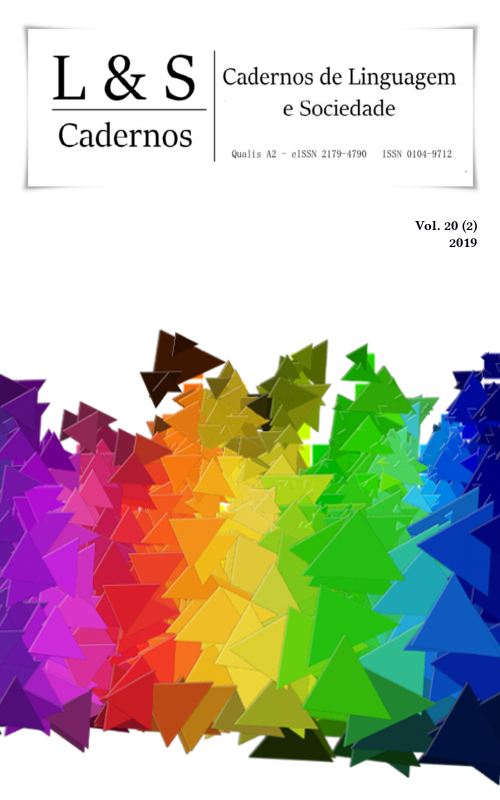CUSSING AMONG THE KANKANAEY YOUTH
DOI:
https://doi.org/10.26512/les.v20i2.24831Palavras-chave:
cuss words, young people, Philippines, cultureResumo
This paper explores the cuss words used by the Kankanaey young people of The Philippines, examines the reasons they use them and if these cuss words reflect their identity. It employs the qualitative approach and uses a semi-structured interview. Most of the cuss words are terms that range from taboo topics such as the genitals, to inoffensive terms such as body parts, to incapacity, and to words borrowed and modified from English, as well as those invented. These cuss words are usually used to express emotions that range from light to strong ones such as anger, disappointment, fright, or surprise.
Downloads
Referências
BRAM, B. Swear words and their implication for English language learning-teaching. LLT Journal: A Journal of Language and Language Teaching, 21, 43-49, 2018.
BURMEISTER, E., & AITKEN, L. M. Sample size: How many is enough? Australian Critical Care, 25, 271-274, 2012.
ETHNOLOGUE. Kankanaey. Retrieved from https://www.ethnologue.com/language/kne. n.d.a.
ETHNOLOGUE. Language status. Retrieved from https://www.ethnologue.com/about/language-status. n.d.b.
FINN, E. Swearing: The good, the bad, the ugly. ORTESOL Journal, 34, 17-26, 2007.
GATI, P. The use of swear words by women: a study of single sex and mix sex conversations. 61-90, 2014.
GEERTZ, C. The interpretation of cultures. New York: Basic Books, 1973.
GUEST, G., BUNCE, A., & JOHNSON, L. How many interviews are enough? An experiment with data saturation and variability. Field Methods, 18(1), 59-82, 2006.
GUMPERZ, J. Discourse strategies. Cambridge: Cambridge University Press, 1982.
HAKUTA, K. Mirror of language: the debate on bilingualism. New York: Basic Books, 1996.
HENRY, D. On cursing. The Massachusetts Review, Volume 59, Number 1, 2018, 91-96, 2018.
JANSCHEWITZ, K. Taboo, emotionally valenced, and emotionally neutral word norms. Behavior research methods, 40(4), 1065-1074, 2008.
JAY, K. & JAY, T. A Child's Garden of Curses: A Gender, Historical, and Age-Related Evaluation of the Taboo Lexicon. The American Journal of Psychology , Vol. 126, No. 4 (Winter 2013), 459-475, 2013.
JAY, T. Cursing in America. Philadelphia, PA: John Benjamins, 1992.
JAY, T. The utility and ubiquity of taboo words. Perspectives on Psychological Science, 4(2), 153-161, 2009.
JAY, T. Why We Curse A Neuro-Psycho-Social Theory Of Speech. John Benjamins Publishing Company: Philadelphia/Amsterdam, n.d.
JAY, T. & JANSCHEWITZ, K. The science of swearing. The Observer, vol. 25 p. 5-6, 2012.
JAY, T. B. Why we curse: A neuro-psycho-social theory of speech. Philadelphia, PA: John Benjamins, 2000.
JAY, T., & JANSCHEWITZ, K. The pragmatics of swearing. Journal of Politeness Research. Language, Behaviour, Culture, 4(2), 267-288, 2008.
KROULEK, A. Swearing: It’s a Cultural Thing. Retrieved from https://www.k-international.com/blog/swearing-its-a-cultural-thing/, 2013
LAGMAY, H. The Inayan Concept Among Igorot. Retrieved from http://livewith prettyheart.blogspot.com. August 12, 2013, 2012.
LAMBERT, V., & LAMBERT, C. Qualitative descriptive research: An acceptable design. Pacific Rim International Journal, 2012.
LEVINE, R. Culture theory. In SHWEDER, R. & LEVINE, R. (Eds.), Culture theory: Essays in mind, self, and emotion. Cambridge: Cambridge University Press, 1984. P. 67-87.
LEYALEY, R. Iyanan: The tenet for peace among the Igorot. International Journal of Advanced Research in Management and Social Sciences. Vol. 5 No. 2. February 2016.
LJUNG, M. Swearing: A cross-cultural linguistic study, 2010.
MAYNARD, S. Japanese communication: Language and thought in context. Honolulu, Hawaii: Univ. of Hawaii Press, 2002.
MEHL, M., & PENNEBAKER, J. The sounds of social life: A psychometric analysis of student’s daily social environments and natural conversations. Journal of Personality and Social Psychology, 84, 857”“870, 2003.
MOKBEL, J. Profanity's relation to personality and impulsivity (Master's thesis, University of Central Florida, Florida). Retrieved from http://stars. library.ucf.edu/cgi/viewcontent.cgi ? article=2438&context=honorstheses19 90-2015, 2013.
MONTAGU, A. The anatomy of swearing. Philadelphia, PA: University of Pennsylvania Press, 2001.
NICOLAU, M. Swear words among young learners: A case study of the elementary students. Retrieved from https:// ojs.atmajaya.ac.id/index.php/ijelt/article/view/825/665, 2016.
NOCELLA, V. Culture and Profanity. Retrieved from https://scienceleadership.org/blog/culture_and_profanity, 2013.
O’REILLY, M., & PARKER, N. Unsatisfactory saturation: A critical exploration of the notion of saturated sample sizes in qualitative research. Qualitative Research Journal, 1-8, 2012.
RAHMAN, S. Swearing: A cross cultural study. Asian and European Languages, 2017.
ROMAINE, S. Language in society: An introduction to sociolinguistics. 2nd ed. New York: Oxford, 2000.
SALZMANN, Z. Language, culture, and society. Boulder, Colorado: Westview Press, 1993.
SHARMA, M. Why the hell are cuss words not included in teaching of Portuguese as foreign language?!. Matraga rio de janeiro, v.25, n.44, 292-317, 292-317, 2018.
SUGANOB-NICOLAU, M. Swear words among young learners: A case study of the elementary students. Indonesian Journal of English Language Teaching, 11(2), 117-132, 2016.
TAJOLOSA, T. D. Conversational topic preferences, taboo words and euphemisms: The case of Philippine male and female university students. Philippine ESL Journal, 76-95, 2012.
Downloads
Publicado
Como Citar
Edição
Seção
Licença
Autores/as que publicam nesta revista concordam com os seguintes termos:
Autores/as mantêm os direitos autorais e concedem à revista o direito de primeira publicação, sendo o trabalho simultaneamente licenciado sob a Creative Commons Attribution 4.0 International license que permite o compartilhamento do trabalho com reconhecimento da autoria do trabalho e publicação inicial nesta revista.



